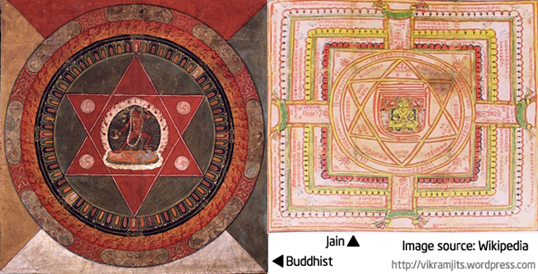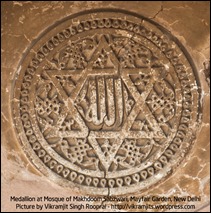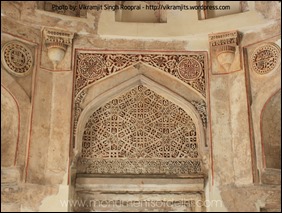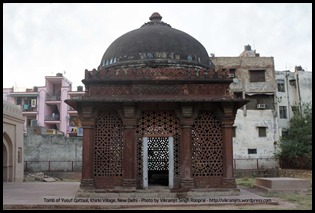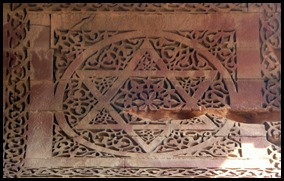In Hinduism, the Hexagram is more commonly known as Shatkon or Satkona (Shat = six, Kona = corner/angle). It is the union of Shiv (Male) and Shakti (Female). Here, Shiva, or the Purusha is represented by symbol “ᐱ”, which is a symbolic representation of male organ. Shakti, or Prakriti is represented by symbol “ᐯ”, which denotes the female womb. They are both combined to form “”. This is called Shanmukha, which represents “Origin”, or the formation of life. Shanmukha literally means Six faced. Hindu deity Kartikeya, Shiv and Shakti’s progeny, is also represented with six faces.
Hexagram is also used in Yantras in Hindu religion. Yantras are used in rituals.

Anahat Chakra or Padam Sundra
The Anahat Chakra or Anahatpuri is one of the seven chakras of Yoga, which is associated with well being, emotions, love and devotion. It contains a lotus flower with twelve petals and an encircled hexagram.
Hexagram in Jainism & Buddhism
Vajrayogini, the highest yoga-tantra Ishta-Devi is practiced to avoid ordinary death and reaching higher spiritual paths. She is a high spiritual figure in Tibet and other areas where Buddhism is practiced. In Tibetan Mandalas, she is drawn in a Hexagram. Some old versions of Tibetan Bardo Tholo (Book of funerary texts) contains Hexagram with Swastika. In Tibetan, it is called the “origin of phenomenon” (chos-kyi ‘byung-gnas). Hexagram is also seen at many places in Jain and Buddhist texts.
Judaism and Christianity
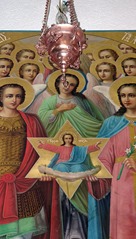
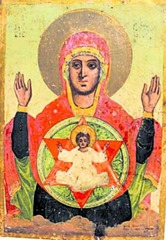

Judaism considers Hexagram as Star of David. While the symbol was used in Jew and Christian texts from centuries, the official use of the Hexagram to represent the Jewish community started from First Zionist Congress in 1897. Soon, it was being used in everything related to Judaism. It became popular to an extend that the flag proposed in first congress later became the official flag of Israel (with minor modifications).
Hexagram can be seen in many churches, where it is part of the architectural patterns. However, at few places, Jesus Christ is depicted in the Hexagram.
One important thing in case of “Star of David”, which usually goes unnoticed is that it is not 2 triangles overlapped. Megan David is actually two triangles interlocked. In almost all other cases, it is the overlapped triangles.
Hexagram in Islam
If you have been to Saudi Arabia, you would know the difference between a Pentagram and a Hexagram. A 5-pointed star has been widely accepted by modern Islamic fundamentalist and they discourage the use of the 6-pointed star. However, this move is more political than religious. Islam considers Moses as one of its prophets and his name appears more than any other prophet in the holy texts. Judaism, Christianity and Islam are all Abrahamic religions and share common roots and beliefs. In South Asia, the Hexagram can be seen on almost all ancient Islamic structures, from tombs to mosques.
In examples below, we have the name “Allah” written inside an Hexagram. It can be seen in the Mosque of Makhdoom Sabzwari in Mayfair Garden near Hauz Khas, New Delhi. The wall on right side is from an unknown tomb in Lado Sarai area of Delhi, where Hexagrams and regular hexagons are used as decorative geometric patterns.
Below, on the left is the Tomb of Sheikh Yusuf Qattaal in Khirki village of New Delhi. This tomb is known for its intrinsic Jaali work. The patterns are derived from Hexagrams. On right, we have the Mehrab of the Mosque of Jamali Kamali in Mehrauli Archaeological Park (Delhi). The mehrab has Hexagrams as medallions.
(Left) Hexagram on Humayun’s Tomb, Delhi. (Right) Hexagram inside Alai Darwaza, one of the oldest surviving true dome gates of South Asia inside Qutub Complex.
Shinto (Japanese)
Hexagram is a common symbol in Shinto. There, it is known as Kagome Crest and can be found in almost all Shinto temples, dating back to 5th century BC.
Rashtrapati Bhawan, Delhi
The Rashtrapati Bhawan and Secretariat designed by Lutyen and Baker is an amazing example of the amalgamation of South Asian and European architecture. Hexagram can be seen almost everywhere in these structures.
The Seal of United States of America
Notice the 5-pointed stars in the US Seal. These stars form a Hexagram.
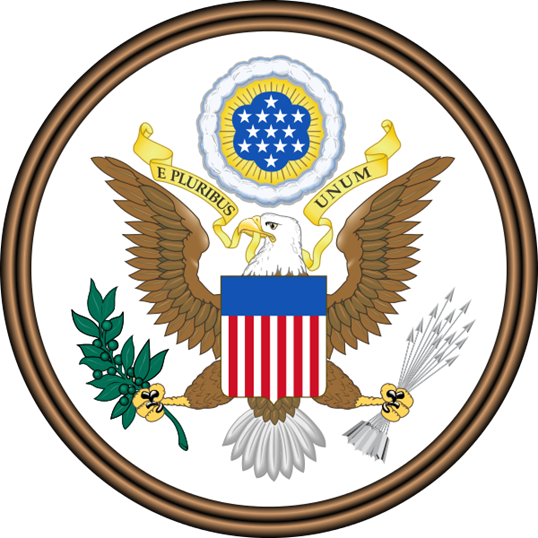
There is a lot more about the Hexagram than what I have mentioned in this article. But I will stop here to avoid converting this article into a mini-book. Please feel free to read through the links given below for more understanding on this subject
For further reading, you may refer to:
- http://star-of-david.blogspot.in/
- http://gosai.com/writings/satkona-star-of-david-or-star-of-goloka
- http://en.wikipedia.org/wiki/Hexagram
- http://www.chabad.org/library/article_cdo/aid/788679/jewish/What-Is-the-Mystical-Significance-of-the-Star-of-David.htm
- http://www.chabad.org/theJewishWoman/article_cdo/aid/434527/jewish/Eves-Shield-of-Protection.htm
- http://en.wikipedia.org/wiki/Star_and_crescent
- https://www.google.com/maps/@-21.8186101,114.1690194,4119m/data=!3m1!1e3?hl=en
